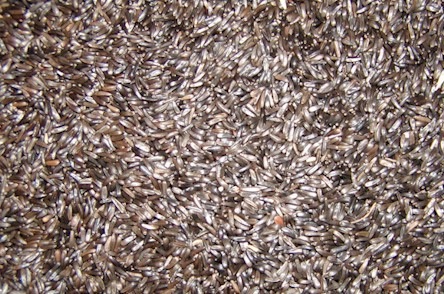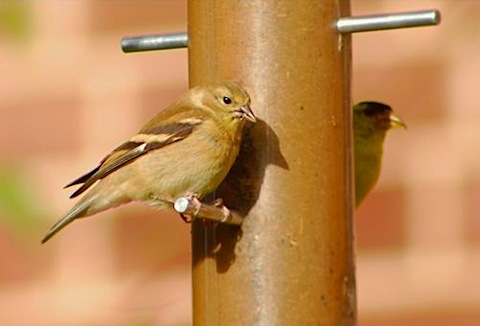Last Saturday was the Minnesota Ornithologists' Union Paper Session (a boring term for annual gathering). One of the presentations was from John and Lisa Loegering about attempts to produce Nyjer in North America.

Let's get some basics down about this seed first, on the off chance that someone reading this doesn't know about the tiny seed for finches. Above is a picture of Nyjer also known as Niger and Thistle. Most of what you purchase for goldfinches at your local feed store comes from Singapore, Burma (I remember seeing that location frequently when I got in 50# bags at the bird store I managed), Ethiopia, and Myanmar. This is not a seed grown in North America. It is in no way related to the noxious weed thistle. It was originally called Niger but frequently got mispronounced as a racial slur. So many retailers referred to it as thistle. Since some got confused that it might be seeds of the noxious weed thistle, some cities tried to ban its sale. The Wild Bird Feeding Industry has pushed for the name to be changed to a phonetic spelling: Nyjer.
Confused yet? Basically at bird stores: Nyjer = Niger = Thistle, it is all the same seed. It's that tiny seed you put out for finches, siskins and redpolls and it's not grown in North America--one of the reasons it's one of the more expensive seeds.
According to the Loegerings, attempts have been made to grow a type of Nyjer in North America. A Niger Growers Group was even formed. By 2002, a plant had been developed and seeds were produced...and no bird would touch it. The group contacted the Loegerings and asked them to figure out why birds wouldn't eat the seeds. They set up 15 different feeding stations with the North American Nyjer in one feeder and Ethiopian Nyjer in the second. They measured the amount of seed put in the feeder, the amount the birds ate, the type of birds and the flock composition. The most common birds coming to the feeding stations were goldfinches and redpolls. Sure enough, if the birds had their choice, they ate the Ethiopian Nyjer more than the North American Nyjer.

Loegering wondered what was different. One of the first things that came to mind was that Ethiopian Nyjer is supposed to be heat treated to prevent it from germinating in North American soil (we all know how successful that is...not). So he got the directions for the exact process and heat treated the North American Nyjer and restarted the experiment. This time, the finches ate both types of Nyjer at the same rate. Now why would they prefer the heat treated seed? Does the heat remove the moisture to make the shell easier to crack? Does it make for a better tasting seed? Does it look different in the UV color spectrum? We don't know.
Now, this does not mean you will be finding locally grown Nyjer anytime soon. The Nyjer Growers Group has since disbanded. Part of the reason is that there is no farm equipment available to separate the tiny seeds from the chaff. Nyjer is all hand harvested overseas, think about that when you are pouring it into your feeder--that is a hand harvested seed. Kind of makes you wonder about the age of the harvesters and if they are paid a fair wage for harvesting that bird seed. Between that and tariffs, you can understand why it's an expensive feed to put out. The other reason was that when corn prices went crazy on all the ethanol speculation, many farmers gave up trying to grow bird food like Nyjer or sunflower (it's costly since you have to protect from the very creatures it is being grown for) in favor of growing corn. They also gave up some of their CRP land, so birds got a raw deal from ethanol...no bird can live in a corn field.
And now a few words from one of my site's sponsors:
Hey! While we're talking Nyjer and finches, you might need one and some are available at the Birdchick's OpenSky Store. One that is pictured quite a bit in my blog and used by thousands of finches is the Finch Flocker (a 36" feeder). There's also the Droll Yankee Clever Clean Series for finches too.
Remember that 20% of the profits of my store are donated to the ABA's kids programs.
